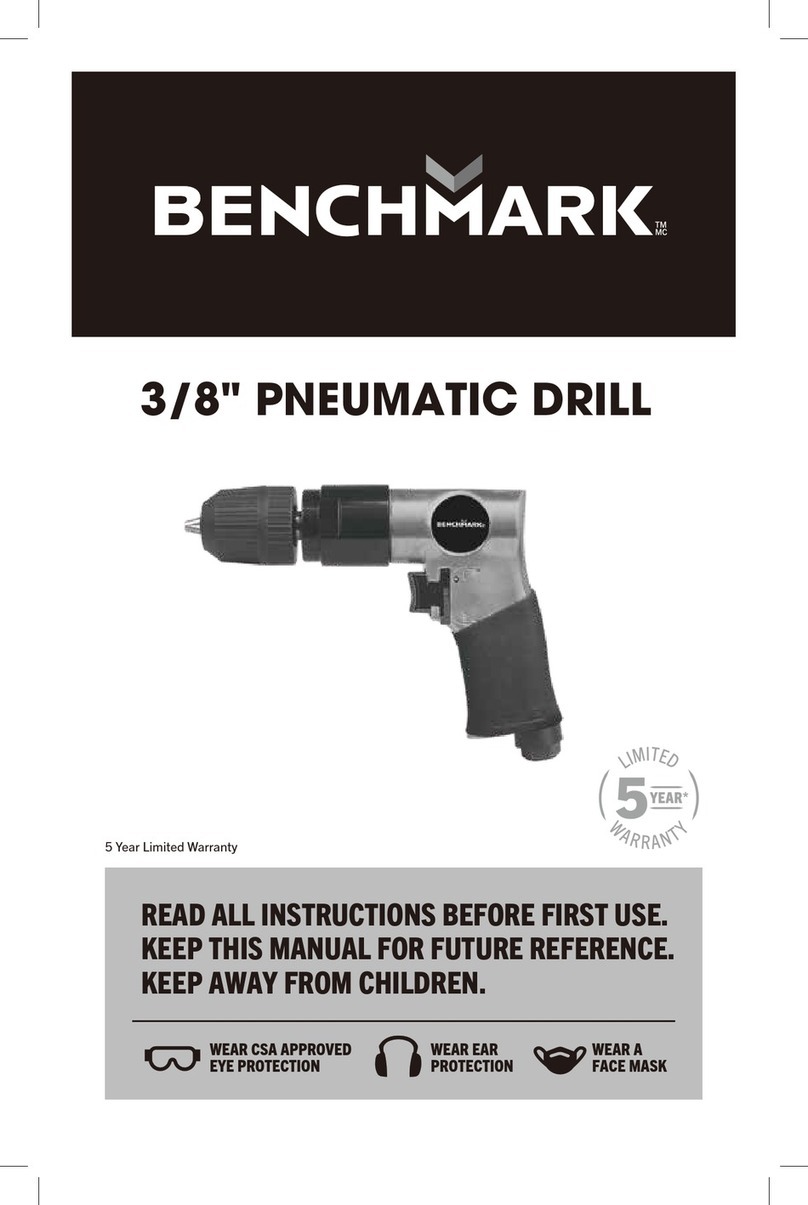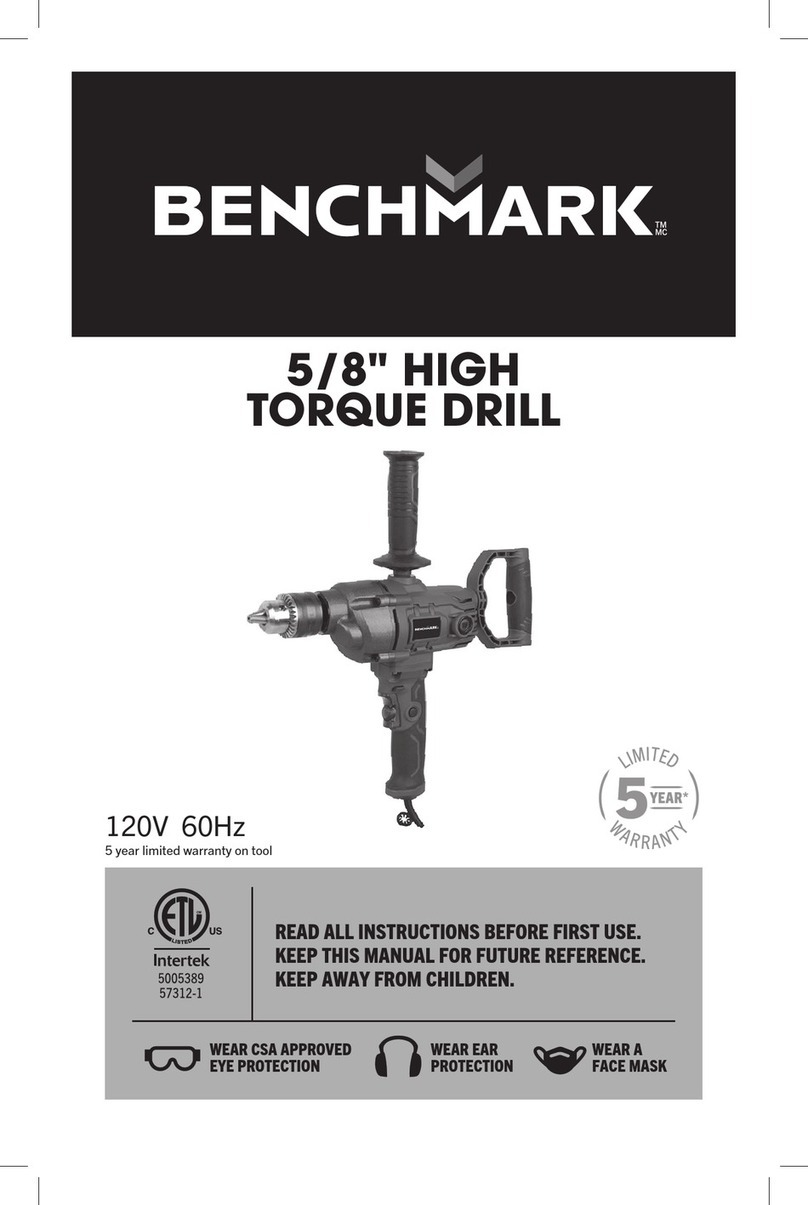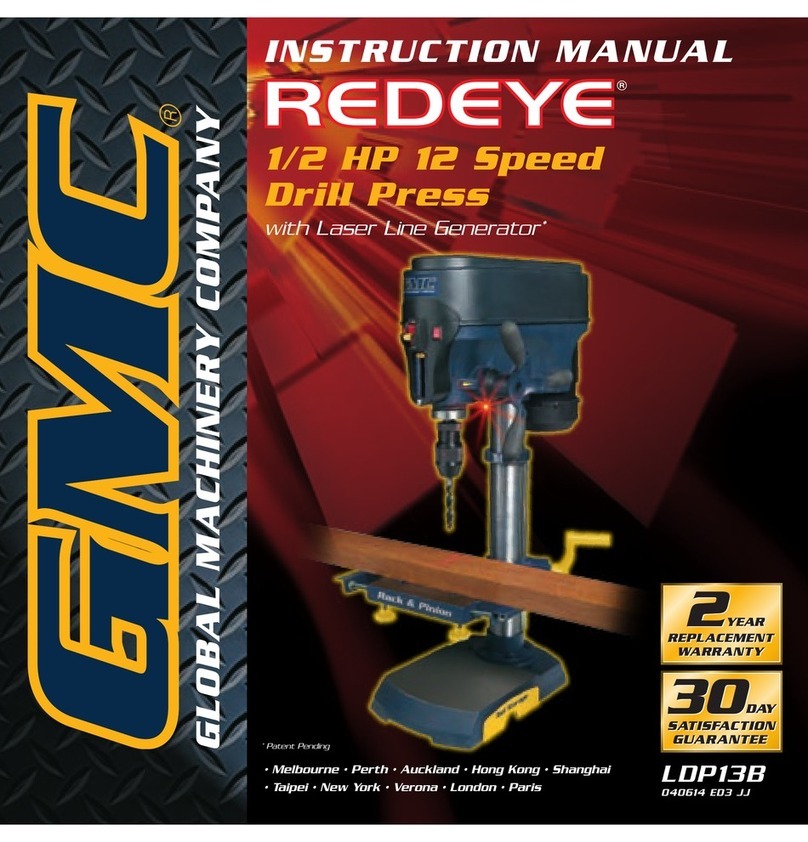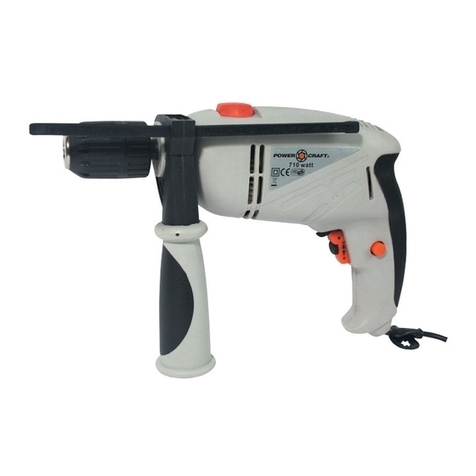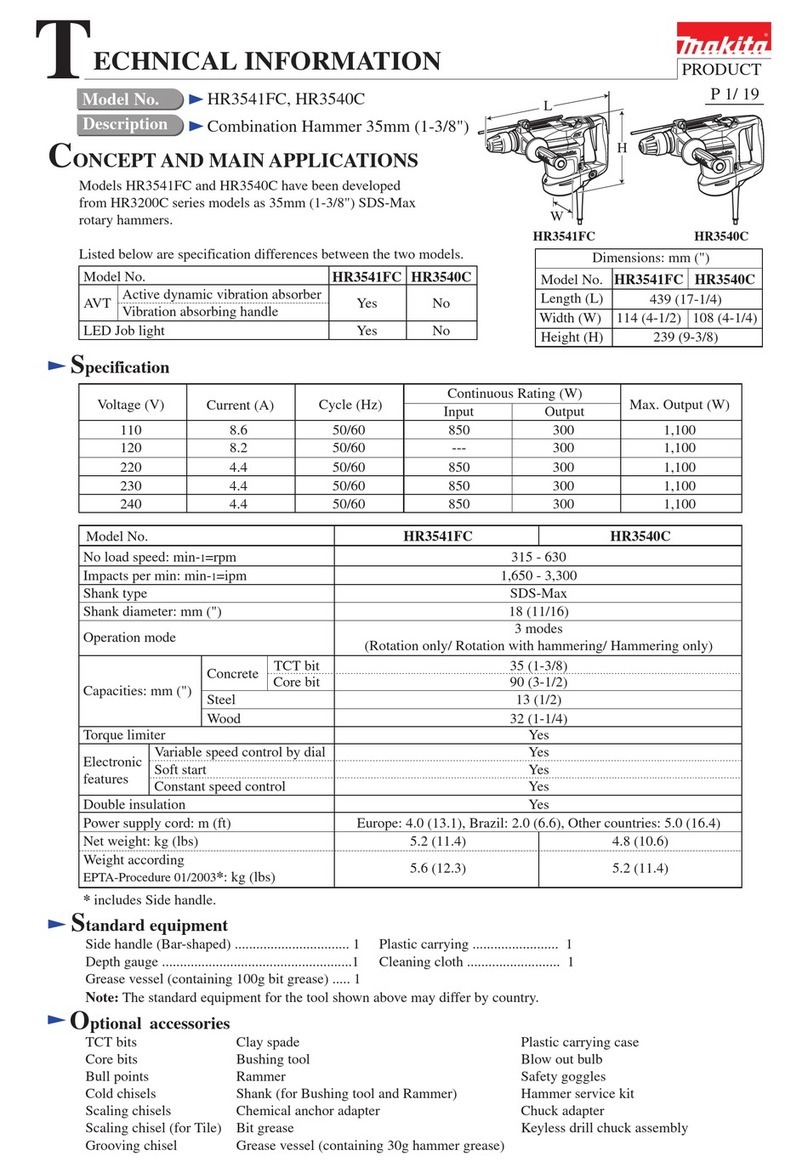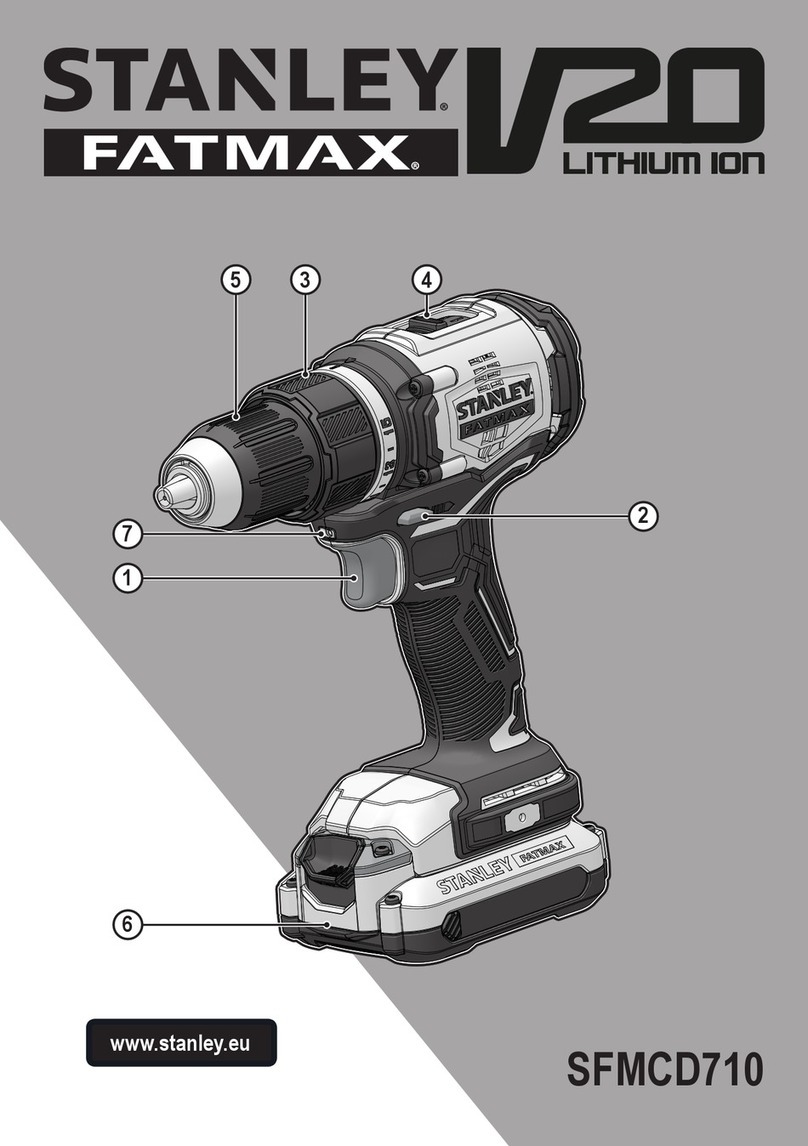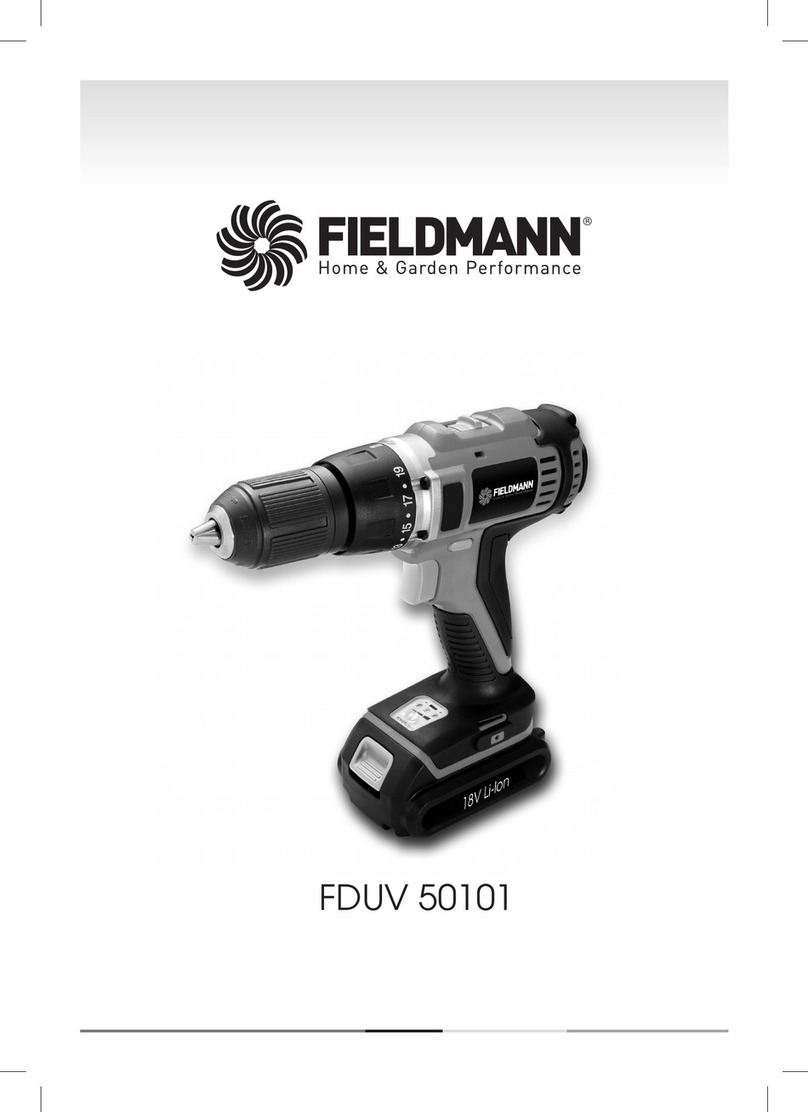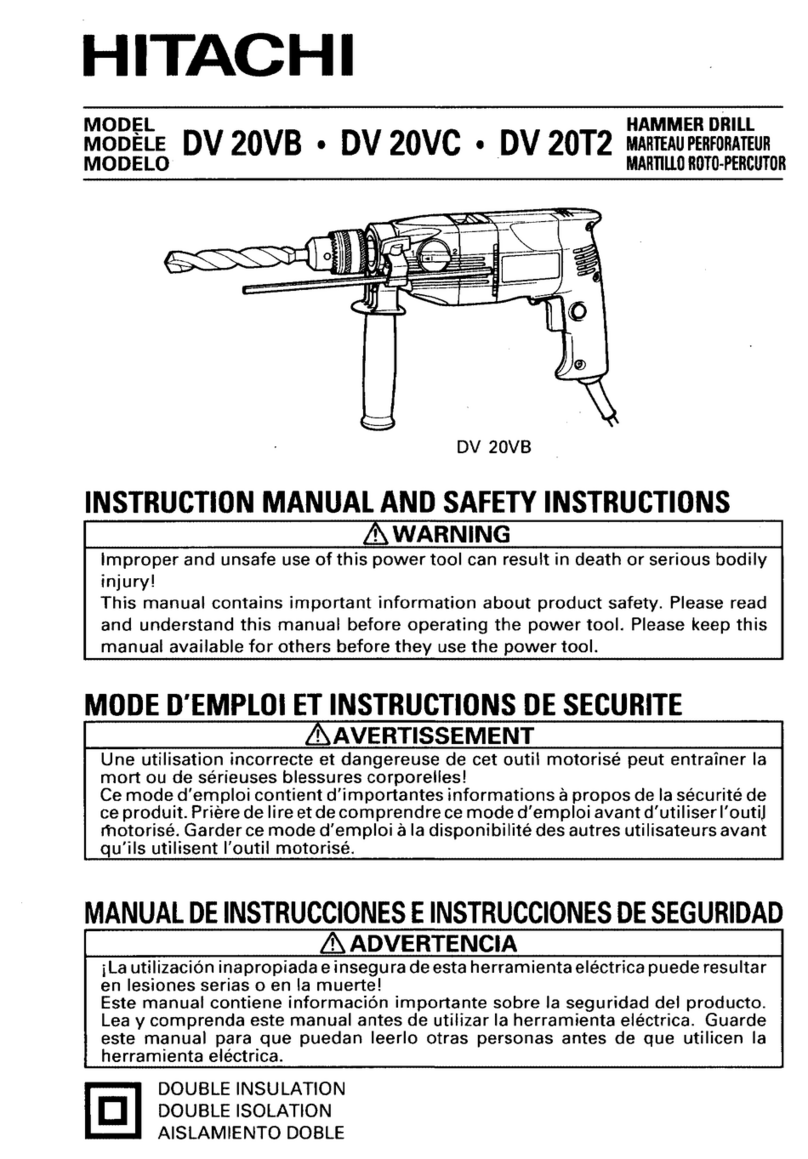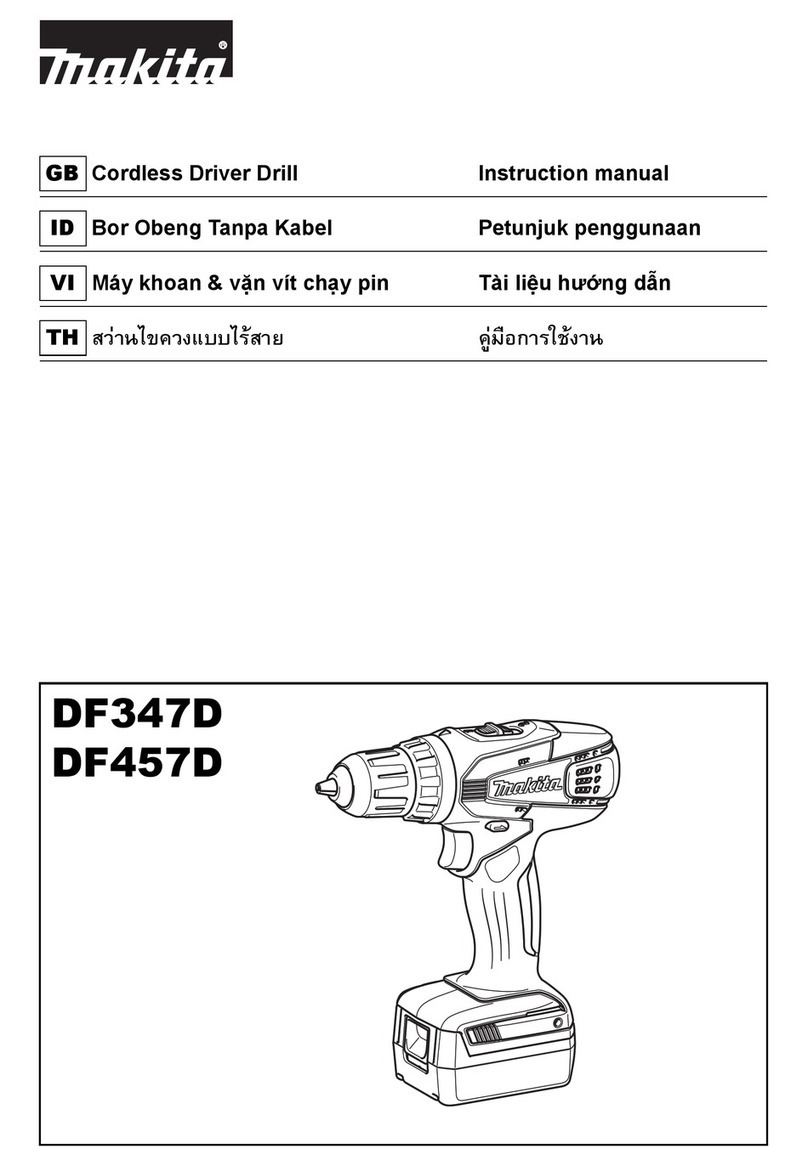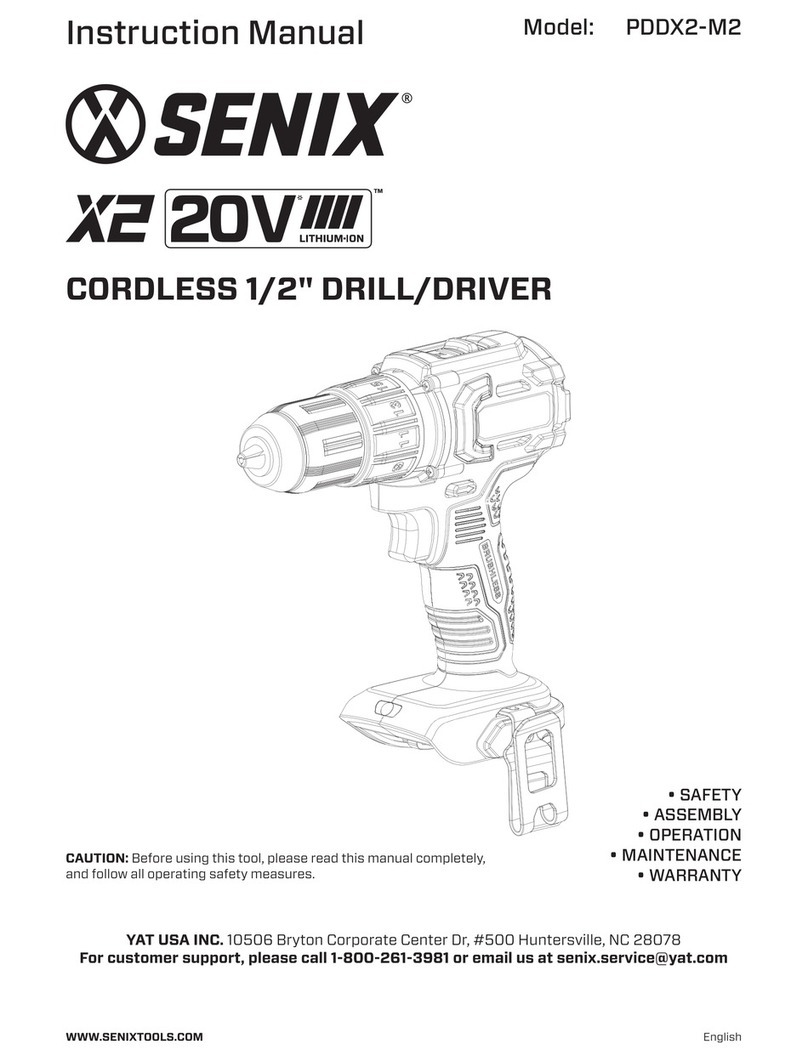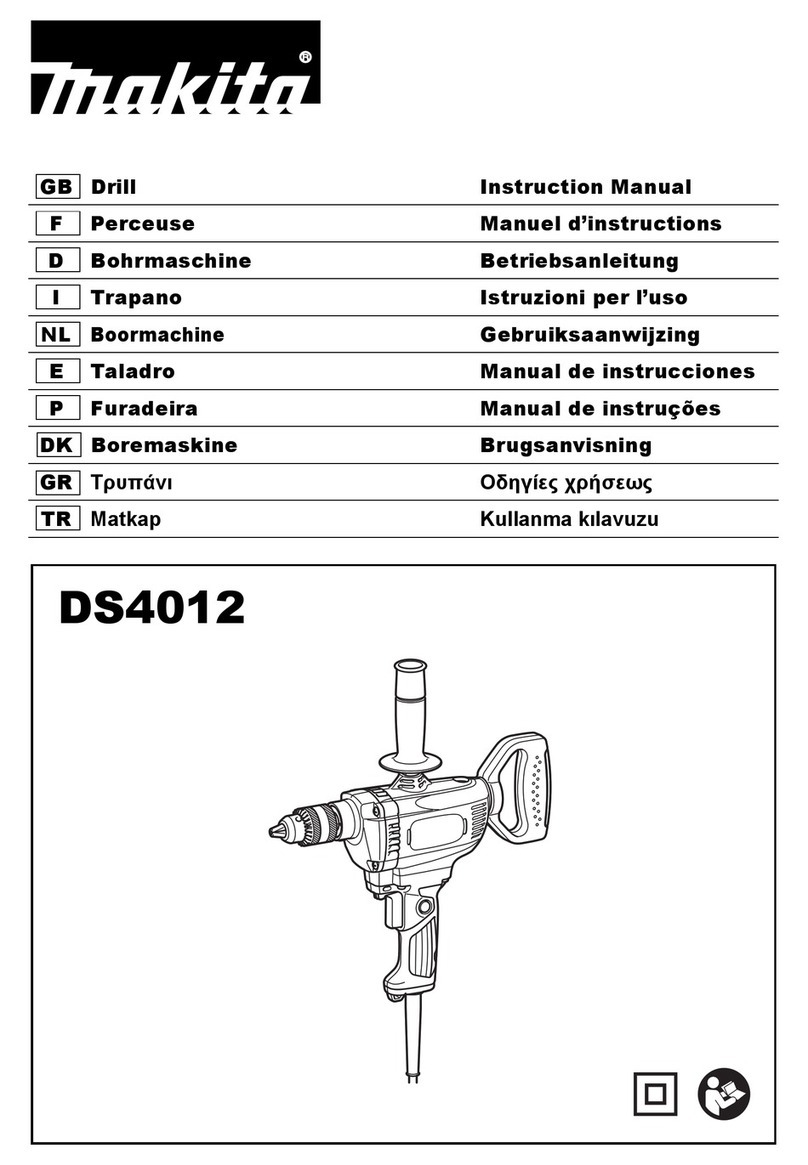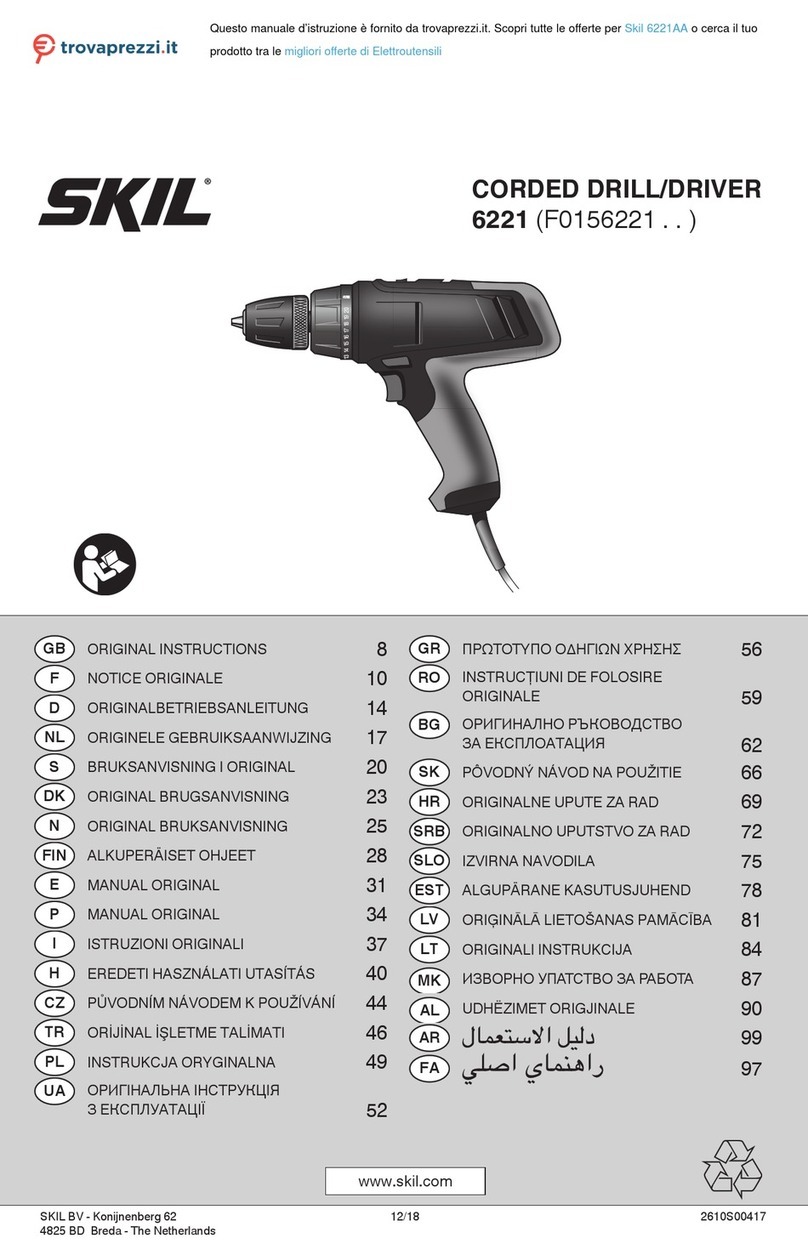Benchmark 1240-000 User manual

READ ALL INSTRUCTIONS BEFORE FIRST USE.
KEEP THIS MANUAL FOR FUTURE REFERENCE.
KEEP AWAY FROM CHILDREN.
WEAR CSA APPROVED
EYE PROTECTION
WEAR EAR
PROTECTION
WEAR A
FACE MASK
5 year limited warranty on tool
1/2" VARIABLE SPEED
HAMMER DRILL
JD2206U
E114847

1
PRODUCT SPECIFICATIONS
7.8 AMP 1/2” 2 SPEED VSR HAMMER DRILL
Rating 120V, 60Hz, AC
Amperes 7.8 AMP
Motor speed 2VS 0-1000 & 0-2700 RPM (no load)
Beats per minute 0-19,000 & 0-51,300 BPM
Chuck ½" Keyed
Maximum drilling capacity in metal ½” (13 mm)
Maximum drilling capacity in wood 1” (25mm)
Maximum drill capacity in concrete 3/8” (10mm)
Weight 6.5lbs (2.95kg)
NEED ASSISTANCE?
Call us on our toll-free customer support line:
1-866-349-8665 (Monday through Friday 9am – 5pm Eastern Standard Time)
• Technical questions
• Replacement parts
• Parts missing from package

1240-000
1/2” VARIABLE SPEED HAMMER DRILL
2
TABLE OF CONTENTS
Product Specifications................................................................................... 1
Table Of Contents .......................................................................................... 2
General Safety Warnings ................................................................................ 3
Eye, Ear & Lung Protection............................................................................. 3
General Safety Rules...................................................................................... 4
Specific Safety Rules ..................................................................................... 6
Symbols......................................................................................................... 8
Know your Hammer Drill ................................................................................ 9
Assembly and Operating .............................................................................. 10
Maintenance ............................................................................................... 18
Exploded view.............................................................................................. 19
Parts list ..................................................................................................... 20
Warranty...................................................................................................... 22

3
GENERAL SAFETY WARNINGS
WARNING:
Before using this tool or any of its accessories, read this manual and follow all Safety
Rules and Operating Instructions. The important precautions, safeguards and
instructions appearing in this manual are not meant to cover all possible situations.
It must be understood that common sense and caution are factors which cannot be
built into the product.
This instruction manual includes the following:
• General Safety Rules • Specific Safety Rules and Symbols
• Functional Description • Assembly
• Operation • Maintenance
• Accessories
EYE, EAR & LUNG PROTECTION
SYMBOL MEANING
ALWAYS WEAR EYE PROTECTION THAT CONFORMS WITH CSA
Z94.3 or ANSI SAFETY STANDARD Z87.1
FLYING DEBRIS can cause permanent eye damage. Prescription
eyeglasses ARE NOT a replacement for proper eye protection.
Non-compliant eyewear can cause serious injury if broken during
the operation of a power tool.
Use hearing protection, particularly during extended periods of
operation of the tool, or if the operation is noisy.
WEAR A DUST MASK THAT IS DESIGNED TO BE USED WHEN
OPERATING A POWER TOOL IN A DUSTY ENVIRONMENT.
Dust that is created by power sanding, sawing, grinding, drilling, and
other construction activities may contain chemicals that are known
to cause cancer, birth defects, or other genetic abnormalities. These
chemicals include:
• Lead from lead-based paints
• Crystalline silica from bricks, cement, and other masonry products
• Arsenic and chromium from chemically treated lumber.
The level of risk from exposure to these chemicals varies, according to
how often this type of work is performed. In order to reduce exposure
to these chemicals, work in a well-ventilated area, and use approved
safety equipment, such as a dust mask that is specifically designed to
filter out microscopic particles.
To avoid electrical hazards, fire hazards or damage to the tool,
use proper circuit protection.
This tool is wired at the factory for 120 Volts AC operation. It must be
connected to a 120 Volts AC, 15 Amps circuit that is protected by a
time-delayed fuse or circuit breaker. To avoid shock or fire, replace
power cord immediately if it is worn, cut or damaged in any way.

1240-000
1/2” VARIABLE SPEED HAMMER DRILL
4
GENERAL SAFETY RULES
WARNING: Read all safety warnings and all instructions. Failure to follow the
warnings and instructions may result in electric shock, fire and/or serious injury.
Save all warnings and instructions for future reference.
WORK AREA SAFETY
Keep work area clean and well lit. Cluttered or dark areas invite accidents.
Do not operate power tools in explosive atmospheres, such as in the presence
of flammable liquids, gases or dust. Power tools create sparks which may ignite
the dust or fumes.
Keep children and bystanders away while operating a power tool. Distractions can
cause you to lose control.
ELECTRICAL SAFETY
Power tool plugs must match the outlet. Never modify the plug in any way.
Do not use any adapter plugs with earthed (grounded) power tools. Unmodified
plugs and matching outlets will reduce risk of electric shock.
Avoid body contact with earthed or grounded surfaces such as pipes, radiators,
ranges and refrigerators. There is an increased risk of electric shock if your body is
earthed or grounded.
Do not expose power tools to rain or wet conditions. Water entering a power tool
will increase the risk of electric shock.
Do not abuse the cord. Never use the cord for carrying, pulling or unplugging
the power tool. Keep cord away from heat, oil, sharp edges or moving parts.
Damaged or entangled cords increase the risk of electric shock.
When operating a power tool outdoors, use an extension cord suitable
for outdoor use. Use of a cord suitable for outdoor use reduces the risk of
electric shock.
If operating a power tool in a damp location is unavoidable, use a residual
current device (RCD) protected supply. Use of a ground fault circuit interrupter
(GFCI) protected supply. Use of a ground fault circuit interrupter (GFCI) reduces
the risk of electric shock.
PERSONAL SAFETY
Stay alert, watch what you are doing and use common sense when operating
a power tool. Do not use a power tool while you are tired or under the influence
of drugs, alcohol, or medication. A moment of inattention while operating power
tools may result in serious personal injury.
Use personal protective equipment. Always wear eye protection. Protective
equipment such as dust mask, non-skid safety shoes, hard hat, or hearing
protection used for appropriate conditions will reduce personal injuries.
connecting to power source and/or battery pack, picking up or carrying the
tool. Carrying power tools with your finger on the switch or energizing power tools
that have the switch on invites accidents.

5
Remove any adjusting key or wrench before turning the power tool on.
A wrench or a key left attached to a rotating part of the power tool may result
in personal injury.
Do not overreach. Keep proper footing and balance at all times. This enables
better control of the power tool in unexpected situations.
Dress properly. Do not wear loose clothing or jewellery. Keep your hair, clothing,
and gloves away from moving parts. Loose clothes, jewellery or long hair can be
caught in moving parts.
If devices are provided for the connection of dust extraction and collection
facilities, ensure these are connected and properly used. Use of dust collection
can reduce dust-related hazards.
POWER TOOL USE AND CARE
Do not force the power tool. Use the correct power tool for your application.
The correct power tool will do the job better and safer at the rate for which it
was designed.
Any power
tool that cannot be controlled with the switch is dangerous and must be repaired.
Disconnect the plug from the power source and/or the battery pack from the
power tool before making any adjustments, changing accessories, or storing
power tools. Such preventive safety measures reduce the risk of starting the
power tool accidentally.
Store idle power tools out of the reach of children and do not allow persons
unfamiliar with the power tool or these instructions to operate the power tool.
Power tools are dangerous in the hands of untrained users.
Maintain power tools. Check for misalignment or binding of moving parts,
operation. If damaged, have the power tool repaired before use. Many accidents
are caused by poorly maintained power tools.
Keep cutting tools sharp and clean. Properly maintained cutting tools with sharp
cutting edges are less likely to bind and are easier to control.
Use the power tool, accessories, and tool bits etc. in accordance with these
instructions, taking into account the working conditions and the work to be
performed.
result in a hazardous situation.
Hold power tools by insulated gripping surfaces when performing an operation
where cutting tool may contact hidden wiring or its own cord. Contact with a
"live" wire will make exposed metal parts of the tool "live" and shock the operator.
Use auxiliary handles supplied with the tool. Loss of control can cause
personal injury.
Wear ear protectors with impact drills. Exposure to noise can cause hearing loss.

1240-000
1/2” VARIABLE SPEED HAMMER DRILL
6
SERVICE
Have your power tool serviced by a qualified repair person using only identical
replacement parts. This will ensure that the safety of the power tool is maintained.
SPECIFIC SAFETY RULES FOR ½” VARIABLE
SPEED HAMMER DRILL
WARNING: Know your hammer drill. Do not plug the hammer drill until you
have read and understand this Instruction Manual. Learn the tool’s applications and
limitations, as well as the specific potential hazards related to this tool. Following
this rule will reduce the risk of electric shock, fire, or serious injury.
Always wear eye protection. Any power tool can throw foreign objects
into your eyes and cause permanent eye damage. ALWAYS wear
safety goggles (not glasses) that comply with ANSI safety standard
Z87.1. Everyday glasses have only impact resistant lenses.
They ARE NOT safety glasses.
WARNING: Glasses or goggles not in compliance with ANSI Z87.1
could cause serious injury when they break.
WARNING: Always use a safety shield, hearing protection and dust mask when
operating the drill in "hammer" mode.
Use only hammer drill bits and accessories that are designed for use with a hammer
drill when using this hammer drill in the hammer mode. Standard drill bits are NOT
designed for use in a hammer drill and MUST NOT be used with a hammer drill in
hammer drill mode. They may shatter and possibly cause serious injury.
Do not drill material too small to be securely held.
Always keep hands out of the path of the drill bit. Avoid awkward hand positions
where a sudden slip could cause your hand to move into the path of the drill bit.
Secure the workpiece. Use clamps or a vice to hold the workpiece. It is safer than
using your hand and it frees both hands to operate the tool.
Know your hammer drill. Do not plug in the hammer drill until you have read and
understand this Instruction Manual. Learn the tool’s applications and limitations,
as well as the specific potential hazards related to this tool. Following this rule will
reduce the risk of electric shock, fire, or serious injury.
Make sure there are no nails or foreign objects in the part of the workpiece
to be drilled.
To avoid injury from accidental starting, always remove the plug from the power
source before installing or removing a drill bit.
Before starting the operation, jog the drill switch to make sure the drill bit
does not wobble or vibrate.
Do not use fly cutters or multiple part hole cutters, because they can come
apart or become unbalanced during use.
Make sure the spindle has come to a complete stop before touching the
chuck or attempting to change the drill bit.
Always make sure the chuck is tight and the drill bit firmly tightened in the
chuck before starting drill.

7
GUIDELINES FOR EXTENSION CORDS
WARNING: Keep the extension cord clear of the working area.
Position the cord so it will not get caught on the workpiece, tools, or any other
obstructions while you are working with the power tool.
Make sure any extension cord used with this tool is in good condition. When using
an extension cord, be sure to use one of heavy enough gauge to carry the current
the tool will draw. An undersized cord will cause a drop in line voltage resulting in
loss of power and overheating.
The table below shows the correct size to use according to cord length and
nameplate ampere rating. If in doubt, use the next heavier gauge. The smaller the
gauge number the heavier the cord.
Be sure your extension cord is properly wired and in good condition. Always have it
repaired by a qualified electrician before using it. Protect your extension cord from
sharp objects, excessive heat and damp or wet areas.
Use a separate electrical circuit for your power tools. This circuit must not be less
than 14-gauge wire and should be protected with either a 15A time delayed fuse
or circuit breaker.
Before connecting the power tool to the power source, make sure the switch is in
the OFF position and the power source is the same as indicated on the nameplate.
Running at lower voltage will damage the motor.
MINIMUM GAUGE (AWG)
Amperage rating Total length
More than Not more
than
25' (7.5 m) 50' (15 m) 100' (30 m) 150' (45m)
0 6 18 16 16 14
6 10 18 16 14 12
10 12 16 16 14 12
12 16 14 12 Not Applicable

1240-000
1/2” VARIABLE SPEED HAMMER DRILL
8
SYMBOLS
WARNING: Some of the following symbols may appear on the hammer drill.
Study these symbols and learn their meaning. Proper interpretation of these
V Volts n
~
Three-Phase Alternating
Current with Neutral
A Amperes Direct Current
Hz Hertz noNo Load Speed
W Watts Alternating or Direct Current
kW Kilowatts Class II Construction
Microfarads Splash-Proof Construction
L Litres Watertight Construction
kg Kilograms Protective Grounding at
Terminal, Class I Tools
H Hours .../min Revolutions or
Reciprocations Per Minute
N/cm² Newtons Per Square
Centimetre Diameter
Pa Pascals 0
OPM Oscillation Per Minute Directional Arrow
Min Minutes Warning Symbol
SSeconds Wear Eye Protection
~or AC Alternating Current Wear Hearing Protection
~
Three-Phase Alternating
Current Wear Dust Mask
This symbol designates that this tool os listed with U.S. repuirements by
MET Laboratories, Inc.
UL62841-1,UL62841-2-1;
CSA C22.2#62841-1,CSA C22.2#62841-2-1.
JD2206U
E114847

9
KNOW YOUR 7.8A ½” HAMMER DRILL
Lock-on
Button
Air Vents
Depth Stop
Rod
Chuck
Drill to Hammer
2 Speed
Selector
Auxiliary Handle
Variable Speed
Trigger Switch
Forward /
Reverse Switch
Chuck Key

1240-000
1/2” VARIABLE SPEED HAMMER DRILL
10
ASSEMBLY AND OPERATING
FORWARD/REVERSE SWITCH
The forward/reverse switch (1) is conveniently mounted in front of the trigger
switch (2) (Fig. 1). To make the drill rotate clockwise for drilling push the forward/
reverse switch to the left. To make the drill rotate counterclockwise, push the
forward/reverse switch to the right.
1
2
Fig. 1 Fig. 2
2
NOTES:
a) Never change the position of the forward/ reverse switch while the
chuck is turning.
b) There is no dead centre position for the for- ward/reverse switch.
The tool will run only when it is in either the full left or full right position.
VARIABLE SPEED TRIGGER SWITCH
This drill is equipped with a variable speed ON/OFF trigger switch.
1. To start drill, gently squeeze the trigger switch (2) (Fig. 2).
NOTE:
The drill will turn at its slowest speed when the trigger switch is depressed slightly.
The drill will turn at its fastest speed when the trigger switch is fully depressed.
2. To stop the drill, release the trigger switch. NOTE: Drilling at a slow speed for an
extended period of time may cause the drill motor to overheat. If drill gets hot,
stop drilling and allow it to cool for at least 15 minutes.
DRILL / IMPACT HAMMER MODE SWITCH
Fig. 3
1

11
The drill / impact hammer switch located on top of the tool (1) changes the drilling
mode between conventional drilling and impact hammer mode for drilling concrete.
To operate the drill in drill mode, turn the drill / impact hammer switch to the right.
(Fig 3). To operate the drill in impact hammer mode, push the drill / impact hammer
switch to the left to the hammer symbol (Fig. 3).
WARNING:
a) Always use a face shield, hearing protection and a dust mask when
drilling in concrete.
b) Always use carbide tipped masonry bits when drilling in masonry. Any other
type of bit could break and possibly cause serious injury.
SPEED SELECTOR
The proper speed selection is directly related to the speed and torque required
for various jobs.
Speed 1 = low speed with high torque. Speed 2 = high speed low torque
Change speed position only with the motor at a complete standstill. To change
speeds, rotate the speed selection dial. (Fig. 3b)
Fig. 3b
INSTALLING DRILL BITS
WARNING:
Never hold the chuck body with one hand and use the drill power to
rotate the drill body to loosen or tighten bits. Serious injury may result.
1. Remove drill plug from the power source.
2. Rotate chuck collar (1) in a counter clockwise direction until the chuck jaws (2)
open wide enough to accept the bit (3) (Fig. 4).
Fig. 4
3. Insert the bit into the chuck the full length of the jaws or until the spiral portion

1240-000
1/2” VARIABLE SPEED HAMMER DRILL
12
of the bit is near the chuck jaws. Raise the front of your drill slightly to prevent
the bit from falling out of the chuck jaws.
4. Tighten the chuck jaws onto the bit by turning the chuck body in a clockwise
direction.
NOTE: Make sure the bit is properly aligned in the jaws and NOT at an angle. An
improperly aligned bit could be thrown from the chuck when the drill is started.
5. Finish tightening the chuck jaws by inserting the chuck key (4) into one of three
holes (5) in the chuck body. Rotate chuck key clockwise until drill bit is held fi
in place by the chuck jaws.
NOTE: Do NOT use a wrench or pliers on the chuck key.
You may damage the key or the chuck.
WARNING:
Do not insert the drill bit into the chuck and tighten as shown in
Fig. 5. The drill bit MUST be properly inserted with all three of the chuck jaws
holding the bit centred in the chuck. Failure to properly insert the drill bit could
cause the drill bit to be thrown from the chuck, resulting in possible serious injury
or damage to the chuck.
Fig. 5
REMOVING DRILL BITS
1. Remove the drill plug from the power source.
2. Insert the chuck key into one of the three holes in the chuck body. Rotate the
chuck key counter clockwise until the chuck jaws release the drill bit.
NOTE: Do not use a wrench on the chuck key or you may damage the key or chuck.
3. Remove the drill bit.
TRIGGER SWITCH LOCK
The trigger switch lock-on feature allows the trigger switch to be locked in the ON
position at full speed when continuous operation for extended periods of time is
required (Fig. 6).

13
Fig. 6
2
3
To lock the trigger switch in the ON position, pull back on the trigger switch (2) to
start the drill. Continue to squeeze the trigger until the drill reaches its maximum
speed. Push the trigger switch lock button (3) into the drill handle.
Release the trigger switch while holding the trigger switch lock button into the drill
handle. The drill will continue to run at full speed. To release the trigger switch lock
button, pull the trigger switch back and then release the trigger.
INSTALLING THE AUXILIARY HANDLE
Install the auxiliary handle (1) for two handed operation of the drill (Fig. 7). This is
particularly important for drilling in concrete.
1. Rotate the auxiliary handle counterclockwise to open mounting collar (2).
2. Slide the auxiliary handle collar overthe chuck andfully onto the drill housing (3).
3. Rotate the auxiliary handle to a comfortable position.
4. Rotate the auxiliary handle clockwise to tighten the mounting collar onto
the drill housing.
Fig. 7
NOTE: Do not over tighten the auxiliary handle. You will break the mounting collar.

1240-000
1/2” VARIABLE SPEED HAMMER DRILL
14
INSTALLING THE DEPTH ROD
The depth rod is used as a gauge to control the depth of the drilled hole.
1. Rotate the auxiliary handle (1) counterclockwise to open the mounting
collar (Fig. 8).
2. Insert the hexagonal depth rod (2) into the matching hole in the auxiliary
handle mounting collar (3).
3. Position the depth rod so the tip (4) will contact the workpiece when the drill
reaches the appropriate depth.
Fig. 8
4 2 3
NOTE: The auxiliary handle must be placed in the horizontal position to allow
depth rod to be inserted into the mounting collar. Tighten the auxiliary handle by
rotating it clockwise.
WARNING:
For safety reasons, the operator must read the sections of this
Owner's Manual entitled “General safety warnings”, “Power tool safety”, “Specific
safety rules”, “Extension cord safety” and “Symbols” before using this drill.
Verify the following every time the drill is used:
1. Safety glasses, safety goggles, or face shield is being worn.
2. Hearing protection and dust mask are being worn when drilling in concrete.
3. The chuck has not worked loose on the spindle.
4. The bit is in good condition and is properly tightened into the chuck.
Failure to observe these safety rules will significantly increase the risk of injury.

15
DRILLING
When drilling into smooth, hard surfaces such as metal, use a centre punch to mark
hold is started.
The workpiece to be drilled should be secured in a vice or with clamps to keep it
from turning as the drill bit rotates (Fig. 9).
Fig. 9
1. Check the drill bit to make sure it is firmly locked into the drill chuck and verify
that the forward/reverse switch is in the forward position.
2. Hold the drill firmly with both hands whenever possible. Use one hand to grasp
the handle and switch.
NOTE: Make sure the hand placed on the body of the drill does not cover the air
vents. Covering these air vents will reduce motor cooling, and possibly lead to
overheating the motor.
3. While holding the drill firmly, place the point of the drill at the point to be drilled.
Squeeze the switch trigger to start the drill.
NOTE: As a general rule, use higher drill speeds when drilling small holes and
slower drill speeds when drilling large holes. When drilling in plastic, use lower drill
speeds for all drill sizes to prevent melting the plastic.
4. Move the drill bit into the workpiece applying only enough pressure to keep the
bit cutting. Do not force the drill bit or apply sideways pressure to elongate the
hole.
WARNING:
Be prepared for binding and bit breakthrough. When these
situations occur, the drill bit has a tendency to grab the workpiece. This action will
kick the drill opposite to the direction of the drill bit rotation, and could cause loss of
control when breaking through material as you complete drilling the hole. If you are
not prepared, this loss of control can result in serious injury.

1240-000
1/2” VARIABLE SPEED HAMMER DRILL
16
When drilling metals, use light oil on the drill bit to keep it from overheating. The oil
will prolong the life of the drill bit and improve the cutting action. If the bit jams in
the workpiece, or if the drill stalls, release the trigger switch immediately. Remove
the bit from the workpiece and determine the reason for jamming.
Fig. 10
REMOVING THE CHUCK
To remove the chuck:
1. Remove the drill plug from the power source.
2. Insert a 5/16” (8 mm) or larger hex key (1) into the chuck (2) and tighten the
chuck jaws securely (Fig. 10). Make sure each of the chuck jaws (3) is seated on
the flat surfaces of the hex key.
3. Tap the hex key sharply with a mallet (4) in a clockwise direction. This action will
loosen the screw in the chuck for easy removal.
4. Open chuck jaws and remove the hex key.
5. Open the chuck jaws as far as possible.
6. Remove the chuck screw using a #2 screwdriver (Fig. 11).
Fig. 11
NOTE: Turn the screw CLOCKWISE to remove it. This screw has a
left-handed thread.
7. Insert the hex key into the chuck and tighten jaws of chuck securely (Fig. 12).
Tap the hex key sharply with a mallet in a COUNTERCLOCKWISE direction. This
will loosen the chuck on the spindle. The chuck can now be unscrewed and
removed from the spindle by hand.

17
RETIGHTENING A LOOSE CHUCK
After installing a chuck that has previously been removed, the chuck may become
loose on the spindle and develop a wobble. Also, the chuck screw may become
loose, causing the chuck jaws to bind and prevent them from closing. To tighten the
chuck, follow these steps:
1. Insert the hex key into the chuck and tighten the chuck securely.
2. Tap the hex key sharply with a mallet in a CLOCKWISE direction (Fig. 13).
This will tighten the chuck on the spindle.
3. Open the chuck jaws and remove the hex key.
4. Tighten the chuck screw using a #2 screwdriver.
NOTE: Turn the screw COUNTERCLOCKWISE to tighten it.
This screw has a left-handed thread.
Fig. 13Fig. 12

1240-000
1/2” VARIABLE SPEED HAMMER DRILL
18
MAINTENANCE
WARNING:
When servicing, use only identical replacement parts. The use of
any other part may create a hazard or cause product damage.
DO NOT use solvents when cleaning plastic parts. Plastics are susceptible to
damage from various types of commercial solvents and may be damaged by their
use. Use a clean cloth to remove dirt, dust, oil, grease etc.
WARNING:
Do not allow brake fluids, gasoline, petroleum-based products,
penetrating oils, etc. to come into contact with plastic parts. They contain
chemicals that can damage, weaken or destroy plastic.
DO NOT abuse power tools. Abusive practices can damage the tool and the
workpiece.
WARNING:
DO NOT attempt to modify tools or create accessories. Any
such alterations or modification is misuse and could result in a hazardous
condition leading to possible serious injury. It will also void the warranty.
LUBRICATION
lubricant for the life of the unit under normal conditions. Therefore, no further
lubrication is required.

19
EXPLODED VIEW
Table of contents
Other Benchmark Drill manuals
